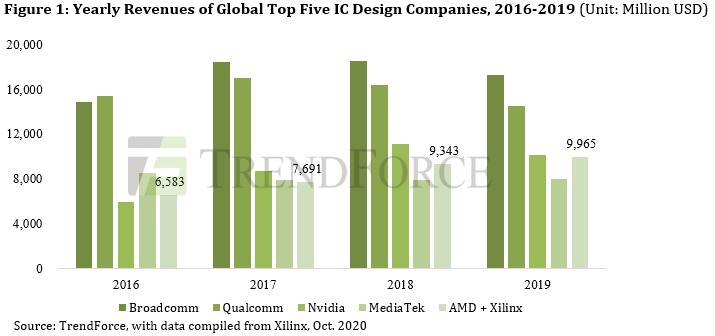AMD Set to Become Fourth Largest IC Design Company After Xilinx Acquisition, Says TrendForce
On October 27, AMD announced that it had reached an agreement with leading FPGA manufacturer Xilinx to acquire the latter for US$35 billion. Should the acquisition proceed as planned, AMD will greatly increase its influence across industries such as 5G, data center, ADAS (advanced driver-assistance systems), and industrial automation, in turn overtaking MediaTek in revenue and becoming the fourth largest IC design company behind third-place Nvidia, according to TrendForce’s latest investigations. Furthermore, as AMD and Xilinx are both major clients of TSMC, AMD will command increased leverage when negotiating for TSMC’s foundry services following the Xilinx acquisition.
Thanks to their strategic approach to acquisitions and vertical integrations, Intel and Nvidia have traditionally performed well in AI, 5G infrastructure, ADAS, and industrial automation. Although AMD falls short in these industries in comparison with Intel and Nvidia, it is quickly catching up by continuing to strengthen its CPU and GPU development and its partnership with TSMC. In light of Intel’s current setbacks in 7nm advanced process development, AMD’s competitiveness in the aforementioned industries is taking a turn for the better.
On the whole, AMD lags behind Intel and Nvidia with regards to product breadth, product adoption, technology, and revenue. By acquiring Xilinx, AMD hopes to close the gap by leveraging the programming flexibility and parallel computing advantages of Xilinx’s FPGA products to generate commercial opportunities in 5G infrastructure, AI, ADAS, and industrial automation. However, Xilinx has suffered YoY revenue drops for the past three quarters due to the U.S.-China trade war. TrendForce analyst CY Yao indicates that, should the trade war further intensify and result in an expanded Entity List, Xilinx will face even more challenges going forward as a result. Therefore, after 18 months, during which AMD and Xilinx are expected to finalize details of the acquisition, AMD’s executive team will be faced with a crucial test for their managerial competencies.
TrendForce believes that effective communication between the two parties is required in order for AMD and Xilinx to integrate and streamline their product positioning strategies, R&D resources, developer tools, and libraries following the acquisition. The integration of software resources, including developer tools and libraries, will present particular difficulties for AMD, since these resources need to be compatible across CPU, GPU, and FPGA product categories.











